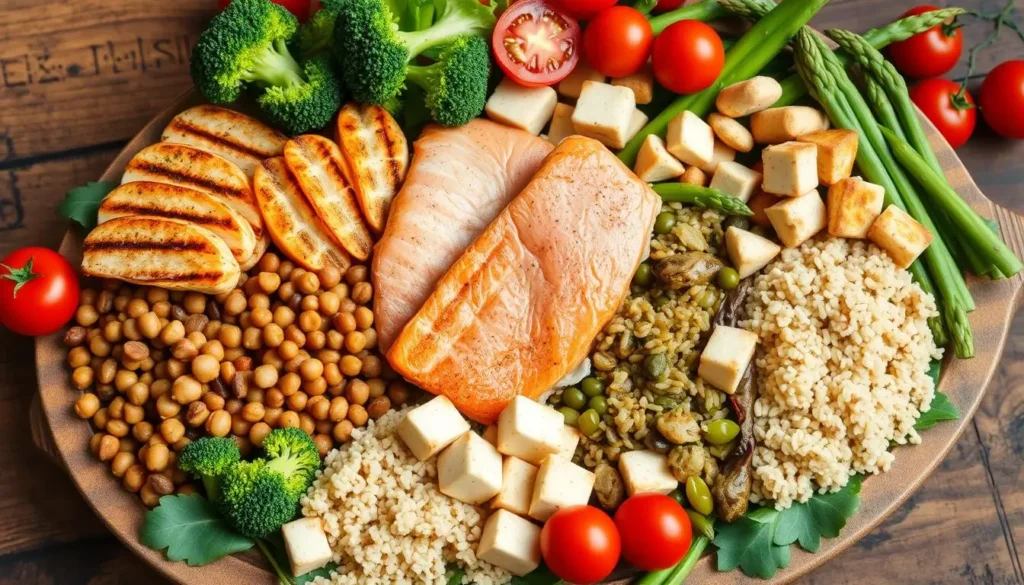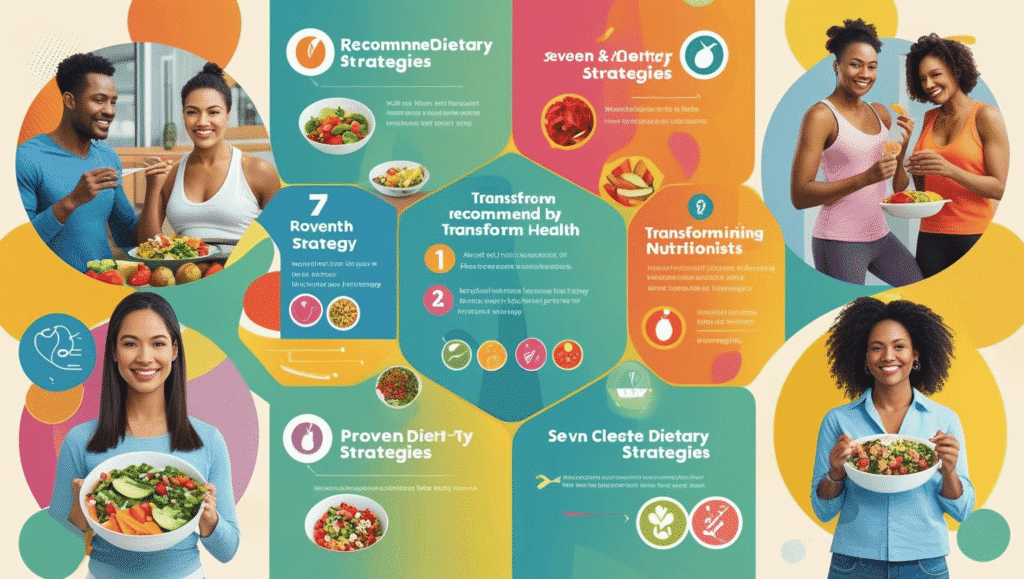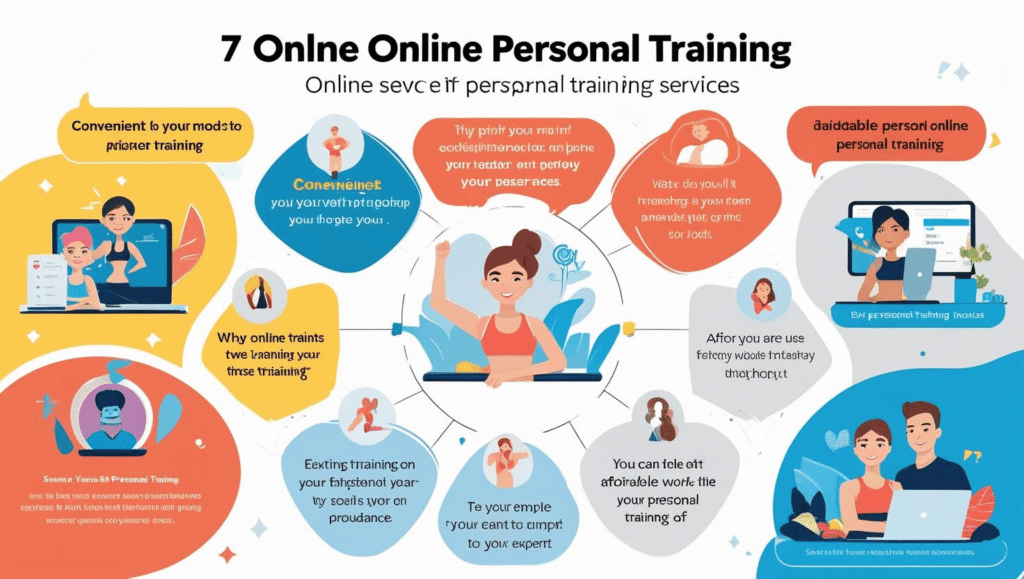Do you feel tired and unhealthy? Eating right might make you feel alive again. Imagine starting each day full of energy, thanks to a diet that makes you feel good.
In this guide, we’ll show you how healthy eating can change your life. You’ll learn to make choices that boost your health and happiness.

Table of Contents
Key Takeaways
- A balanced diet is crucial for optimal health and well-being.
- Incorporating more fruits, vegetables, whole grains, and lean proteins can boost energy and reduce disease risk.
- Mindful eating and portion control are essential for weight management and overall nutritional balance.
- Meal planning and preparation can help establish a consistent, healthy eating routine.
- Addressing barriers to healthy eating, such as busy lifestyles and cravings, can lead to long-term success.
Healthy eating habits open up a world of benefits. You’ll feel more energetic, manage your weight better, and lower your risk of diseases. The power of eating right is clear.
Let’s start a journey to change how you see food. We’ll work together to make you healthier and happier.
What is a Balanced Diet?
A balanced diet is key for staying healthy. It has the right mix of carbs, proteins, fats, vitamins, minerals, and fiber. This helps your body work well and keeps you healthy.
The Importance of Balanced Nutrition
Eating many different foods is good for you. A balanced diet lowers the risk of serious diseases like heart disease and cancer. It also boosts your energy and helps you stay at a healthy weight.
Macronutrients: Carbs, Proteins, and Fats
Carbs give you energy, proteins help you grow, and fats are good for your brain. Finding the right mix of these is important for a healthy diet. Guidelines say carbs, proteins, and fats should be a certain part of your diet.
“Eating a balanced diet is not about depriving yourself, but rather about nourishing your body with the right nutrients to help you feel your best.” – Registered Dietitian
Learning about macronutrients and following guidelines helps you eat well. This supports your health and happiness.
Increase Your Fruit and Vegetable Intake
Fruits and vegetables are key to a healthy diet. They give us vitamins, minerals, fiber, and antioxidants. These are important for our health. Many studies show eating more fruits and veggies can lower heart disease and cancer risks.
But, many people don’t eat enough. They should aim for at least 5 servings a day.
Creative Ways to Add More Produce
Try new ways to eat fruits and veggies. Add spinach or kale to smoothies. Roast veggies as a tasty side. Or, eat fresh fruit all day.
All types of produce count towards your goal. Choose canned or frozen with little sodium and sugar. Adding more fruits and veggies to your diet can improve your heart health and lower cancer risk.
“Eating a diet high in fruits and vegetables can lower your risk of heart disease, cancer, diabetes, and other chronic diseases. Fruits and vegetables are also low in calories and high in fiber, which may help with weight management.” – Harvard Health Publishing
Choose Whole Grains Over Refined Carbs
It’s time to switch from refined grains to whole grains. Whole grains like brown rice and quinoa are better than refined carbohydrates like white bread. Refined grains lose most of their fiber and nutrients during processing.
Whole grains are full of dietary fiber. This fiber makes you feel full, helps control blood sugar levels, and keeps your digestive system healthy.
Whole grains keep more of their natural vitamins, minerals, and antioxidants than refined grains. These nutrients are key for staying healthy. Switching to whole grain foods boosts your diet’s nutrient density.
To find whole-grain products, check if “whole grain” is at the start of the list. In the U.S., whole grains are the best choice for nutrition. Adding different whole grains to your meals brings more health benefits.

The Dietary Guidelines for Americans say to eat half your grains as whole grains. Making this change can greatly improve your health. High-fiber diets can lower heart disease and diabetes risks.
Whole-grain foods can also lower bad cholesterol and blood pressure. They help you feel full, which can aid in weight management.
Incorporate Lean Protein Sources
Protein is key for muscle growth and repair. Eating lean protein makes you feel full longer. It’s good for your health. Most people need 1.2-2.0 g of protein per kg of body weight daily.
Lean Meat, Poultry, and Fish Options
Lean meats like chicken and turkey are great for your diet. Chicken breast has 25.9 g of protein per 3-ounce serving. Turkey breast has 25.6 g of protein per 3-ounce serving. Cod fish has 19.4 g of protein in a 3-ounce serving. Extra-lean beef has 23.5 g of protein in 100 grams.
Plant-Based Protein Alternatives
Plant-based proteins are good for those who don’t eat animal products. Tofu, lentils, and beans are full of protein. A cup of cooked lentils has 17.9 g of protein. Extra-firm tofu has 6.22 g of protein per 3-ounce serving. Plant proteins are low in saturated fats and high in fiber.
Mixing different protein sources is best for your body. Lean meats, fish, and plant proteins help build muscle and keep you full. This supports your health and well-being.

| Protein Source | Protein Content |
|---|---|
| Skinless Chicken Breast | 25.9 g per 3-ounce serving |
| Whey Protein Isolate Powder | 25 g per 28 g serving |
| Cooked Lentils | 17.9 g per 1-cup serving |
| 1% Cottage Cheese | 28 g per 1-cup serving |
| Fat-free Greek Yogurt | 17.5 g per 6-ounce serving |
| Cod Fish | 19.4 g per 3-ounce serving |
| Skinless Turkey Breast | 25.6 g per 3-ounce serving |
| Extra-firm Tofu | 6.22 g per 3-ounce serving |
| Extra-lean Beef | 23.5 g per 100-gram serving |
| Egg Whites | 7 g per 2 egg whites |
| Venison | 30.9 g per 3-ounce serving |
“Plant sources of protein, such as beans, peas, lentils, and nuts, do not contain saturated fats and provide dietary fiber and other nutrients.”
Red meats have more saturated fat than lean proteins. Eating too much meat is not healthy, especially for heart health. A mix of lean proteins supports your health and wellness.
Healthy Eating Habits
Healthy eating is more than picking the right foods. It’s also about watching portion sizes and eating mindfully. By listening to your body, you can keep your energy balanced.
Portion Control and Mindful Eating
Knowing the right portion sizes is key to healthy eating. Most people eat only half the veggies they should. Paying attention to hunger and fullness helps avoid too much food.
Eating slowly and without distractions helps too. Studies show keeping a food diary helps with weight loss.
Meal Planning and Preparation
Planning meals and preparing food are crucial for healthy eating. Dried beans are cheap and full of protein. Planning meals and snacks ahead makes healthy choices easier.
Having meals ready can stop you from eating unhealthy food. Keeping chopped veggies for snacks makes them as easy as chips.

“The more often a person eats high-sugar or high-fat foods, the more they develop a taste for them.”
Healthy eating habits like portion control and meal planning are good for you. They help avoid diseases like diabetes and heart disease.
Limit Saturated Fats and Added Sugars
Eating right is key for your health. Fats and sugars are good, but too much is bad. Too much saturated fat can hurt your heart. Added sugars in foods and drinks don’t help and can make you gain weight.
The Dietary Guidelines say to eat less than 10% of your calories from added sugars. Also, don’t eat more than 10% of your calories from saturated fats, starting at age 2. Reading labels and choosing wisely can help your health.
The Guidelines also say to eat less sodium, especially for kids. Men should drink no more than 2 drinks a day, and women 1.
By following these tips, you can make your heart healthier and lower disease risks. Eat mostly nutrient-dense foods, about 85% of your calories. Eating a variety of foods and watching portion sizes also helps.

“Following the Dietary Guidelines could improve Americans’ health according to research.”
Don’t try to change everything at once. Start with small steps towards a better diet.
| Nutrient | Recommended Intake | |
|---|---|---|
| Added Sugars | Less than 10% of total calories | |
| Saturated Fats | Less than 10% of total calories | |
| Sodium | Less than 2,300 mg per day | |
| Alcohol | Men: 2 drinks or less per day | Women: 1 drink or less per day |
Changing your diet is a journey, not a goal. Focus on balance and moderation for a better life.
Stay Hydrated with Water and Unsweetened Beverages
Drinking enough water is key for our bodies. It helps keep us cool, aids digestion, and boosts brain power. About 60% of an adult’s body is water.
The daily water need is about 3.7 liters for men and 2.7 liters for women. Drinking plain water is the best way to stay hydrated.
Other good drinks include herbal tea, sparkling water, and flavored waters. But, don’t overdo it with caffeine. Up to 400 mg a day is okay, like 3 to 5 cups of coffee.
Avoid sugary drinks like sodas and juices. They can make you gain weight and harm your health.
Drinking water all day can make you feel better. It boosts energy and sharpens your mind. Schools and other places are talking about making healthier drinks available.
“Proper hydration is essential for maintaining optimal health and well-being. Drinking enough water can help you feel more energized, focused, and alert throughout the day.”
Develop a Consistent Eating Schedule
Having regular mealtimes is good for your health. Our bodies work best when we eat at the same times every day. Eating at odd times can make us more likely to get sick.
It’s important to eat when our body’s clock says it’s time. This helps us stay healthy. If we don’t, it can mess up our diet and make us feel off-balance.
The Importance of Regular Mealtimes
Eating at the same times helps us get the right amount of food. It keeps our energy up and stops us from getting too hungry. Drinking coffee can make us not want to eat breakfast.
Eating every 3 to 4 hours keeps our blood sugar steady. This can help us avoid getting sick and keep our heart healthy.
- Good meals are oatmeal with fruit, salmon with rice and broccoli, and chicken with noodles.
- Snacks like apples, nuts, and yogurt keep us going between meals.
It’s key to eat when we’re hungry, not just because it’s time. What works for one person might not work for another. Our body’s clock helps us stay healthy by telling us when to eat and move.
Eating all your food in an 8- to 12-hour window is good for your heart. Fasting can make your brain work better. Eating less can also be good for you.
Eating too close to bedtime can make you gain weight. But eating earlier can help you lose weight and control your blood sugar. Eating less than 12 hours a day and avoiding late-night snacks can make you healthier.
“Following a consistent eating schedule, including meals such as breakfast within two hours of waking, a midday lunch, and an early dinner, aligns with research-backed recommendations to enhance health outcomes.”
By eating at regular times, you can keep your energy up, control hunger, and live a healthy life.
Overcoming Barriers to Healthy Eating
Eating healthy can be hard, especially with busy lives and cravings. But, you can beat these challenges. You can make a lasting change to your diet.
Strategies for Busy Lifestyles
Busy people can meal prep and keep healthy snacks ready. This makes a big difference. The USDA backs Iowa State University’s Spend Smart-Eat Smart program. It has over 100 cheap recipes and nutrition tips.
Looking at grocery ads online can save money. You can plan meals with sale items. Store-brand foods are just as good as name brands, but cheaper.
Addressing Food Cravings and Emotional Eating
Dealing with cravings and emotional eating is tough. But, it’s key to a balanced diet. Mindfulness, healthy choices, and stress management help a lot. It takes about 3 months to change food tastes, showing habits change slowly.
Planning meals for a week can stop spontaneous eating out. This shows meal planning helps eat healthier.
Anticipating and solving these problems helps keep your healthy eating on track. The USDA offers tools like MyPlate and the Food and Nutrition Information Center. The Eldercare Locator helps find places for free or cheap meals. Changing habits takes time, but with the right plan, you can beat eating barriers and feel better.
“The first step towards getting somewhere is to decide that you are not going to stay where you are.” – J.P. Morgan
The Benefits of Healthy Eating Habits
Eating healthy is good for you in many ways. It boosts your energy, helps with weight, and lowers disease risk. A balanced diet makes you feel better physically and mentally. It helps you live a healthier, happier life.
Improved Energy and Weight Management
Eating the right foods gives you energy all day. It keeps your blood sugar steady, so you don’t feel tired. Foods high in fiber and protein help you feel full and digest better.
Reduced Risk of Chronic Diseases
Healthy eating lowers your risk of serious diseases like heart disease and diabetes. Eating lots of fruits, veggies, and lean proteins is key. It keeps your blood pressure and sugar levels in check. Plus, it boosts your immune system with vitamins and minerals.
Choosing healthy foods improves your energy, weight, and disease risk. It’s a smart choice for you and your family’s health.
Conclusion
Starting a journey to eat healthier is a big step. It can make you feel better in many ways. Eating foods full of nutrients, controlling how much you eat, and eating at regular times helps a lot.
Changing your lifestyle for the better is hard sometimes. But the good things you get in the long run are worth it.
Start with small steps towards being healthier. Be proud of yourself as you get better. With hard work and kindness to yourself, you can keep eating well for a long time.
The journey to being healthier is ongoing. It’s about learning and growing every day. Enjoy the benefits of eating well for a long, happy life.
FAQ
What is a balanced diet?
How can I increase my fruit and vegetable intake?
What are the benefits of choosing whole grains over refined carbs?
How can I incorporate lean protein sources into my diet?
Why is portion control and mindful eating important for healthy habits?
How can I stay hydrated throughout the day?
What are the benefits of having a consistent eating schedule?
How can I overcome barriers to healthy eating?
10 Easy Meal Prep Books for Healthy Eating on a Busy Schedule (2025)
Finding time to eat healthy as a busy professional can feel impossible when you’re juggling meetings, deadlines, and personal commitments. The 10 easy meal prep books for healthy eating on a busy schedule (2025) offer proven solutions that help you reclaim your nutrition without sacrificing precious time. These expertly curated guides provide step-by-step systems for batch cooking, meal planning, and creating nutritious meals that fuel your success.
Source Links
- 8 tips for healthy eating
- Balanced Diet: What Is It and How to Achieve It
- Tips for Healthy Eating for a Healthy Weight
- Eating a balanced diet
- Vegetables and Fruits
- Simple, inexpensive ways to eat more fruit and veggies
- How to Eat More Fruit and Vegetables
- The whole truth about whole grains
- Get to Know Grains: Why You Need Them, and What to Look For
- 11 Low-Fat Proteins To Add to Your Diet
- Picking Healthy Proteins
- 11 Ways to Stick With Healthy Eating Habits
- 11 tips for healthier eating habits – Mayo Clinic Press
- Healthy diet
- Top 10 Things You Need to Know About the Dietary Guidelines for Americans, 2020-2025
- Oils, Added Sugars, Saturated Fats, Sodium, and Alcohol
- New dietary guidelines urge Americans to eat less added sugars, saturated fat, and sodium
- About Water and Healthier Drinks
- Why eating on a regular schedule supports overall well-being – Johns Hopkins University Student Well-Being
- Scheduled Eating- Why It’s Beneficial and How to Start – Center for Healthy Eating and Activity Research
- When to Eat: The Importance of Eating Patterns in Health and Disease
- Overcoming Roadblocks to Healthy Eating
- Healthy Eating: Overcoming Barriers to Change
- Healthy diet
- 8 mind-body benefits of eating healthy
- Health benefits of eating well
- Benefits of eating healthy: Heart health, better mood, and more
- Healthy Eating as a New Way of Life: A Qualitative Study of Successful Long-Term Diet Change
- Early Childhood Food And Nutrition Conclusion




